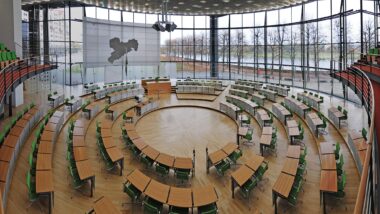Ushahidi ist eine freie Software mit einer beeindruckenden Geschichte: Innerhalb weniger Tage während der Unruhen nach den kenianischen Wahlen vor zwei Jahren als einmaliges Projekt auf die Beine gestellt, wird Ushahidi heute von dutzenden Organisationen weltweit genutzt, um Wahlbetrug, Umweltvergehen oder Menschenrechtsverstöße auf die Karte zu bringen. Nach dem Gewinn diverser Auszeichnungen arbeitet ein internationales Team an der Weiterentwicklung von Ushahidi. Die derzeitige Version 1.0 „Mogadishu“ kann kostenlos heruntergeladen werden.
Patrick Meier ist Mitglied des Vorstandes von Ushahidi und dort zuständig für Crisis Mapping und strategische Partnerschaften. Patrick ist Doktorand an der Fletcher School of Law & Diplomacy und arbeitet als Berater für diverse internationale Organisationen. Im vergangenen Jahr gründete er mit Kollegen das International Network of Crisis Mappers. Patrick bloggt auf iRevolution und Early Warning.
Simon Columbus: We are talking about a software, Ushahidi. Which word do you think describes Ushahidi the best?
Patrick Meier: Hmmm (let me think)… awareness.
Simon Columbus: Awareness. I thought you might say „Ushahidi“ – the term sounds a little strange to Western ears, but it has a meaning, doesn’t it?
Patrick Meier: Ushahidi means „testimony“ or „witness“ in Swahili.
Simon Columbus: Which is pretty close to awareness… So what is Ushahidi?
Patrick Meier: Ushahidi is a free and open source platform that allows organizations to crowdsource information and to visualize this information dynamically on a map.
Simon Columbus: That sounds really technical. Can you delve a little deeper into Ushahidi’s structure?
Patrick Meier: Sure thing. Ushahidi simply aggregates information, so users can text in information or tweet in or go directly on the Ushahidi website and enter in information that way. The easiest way to think of Ushahidi is as a clever website, which you can send information to using different communication technologies. Information on human rights abuses, for example, or human trafficking. This information can then be mapped geographically, such as riots in a particularly neighborhood of Tehran.
Simon Columbus: What is mapping such information good for? In the last years, you have worked hard to establish „crisis mapping“ as an academic field, so it is more than just a nice overview, I guess?
Patrick Meier: Sometimes it’s easier to understand information when it is mapped. For example, take a spreadsheet with lots of numbers: It may be difficult to make sense of the spreadsheet, but one could take the numbers and graph them, which would reveal more about the information. The same is true with mapping. It is simply a way to visualize information in order to reveal more about said information, e.g., like patterns. And yes, crisis mapping as a field is not just about mapping. It’s about information collection, data visualization, geospatial analysis and decision-support for operational response.
Simon Columbus: And Ushahidi provides a tool for the first two?
Patrick Meier: Yes, that’s right. And we have plans to include functionalities for geospatial analysis and later on exploring ways to render the platform useful for decision-support.
Simon Columbus: That sounds very interesting! Can you explain how that would look like?
Patrick Meier: Sure. On analysis, one common technique in geospatial analysis is clustering to identify where there are patterns of clustered data, which is not always visible when one has a lot of data on the map. On decision-support (which will come later), we hope to add functionalities that will allow users to query the data, i.e., to ask certain questions in order to better decide on a course of action. But all this will come later. Right now we’re focusing on visualization as the next step in the crisis mapping process. The built-in analysis features will most likely come towards the end of the year.
Simon Columbus: But you are currently working on another side-project to enhance Ushahidi, Swift River, aren’t you?
Patrick Meier: yes, that’s right. Swift River is part of the information collection phase that I described earlier. The four pillars of crisis mapping are: 1. info collection, 2. visualization, 3. analysis, 4. decision support. So we’re now focusing our efforts and 1 and 2.
Simon Columbus: Can you describe a little what Swift River is about?
Patrick Meier: Swift River will allow users to validate information in near real time. The advantage of crowdsourcing is that you can collect information from multiple sources, but some of these sources may be unknown or unofficial sources, so you don’t know if you can rely on them. Swift River will be able to rate the probability that collected information is genuine. Does that make sense?
Simon Columbus: It does. But how is that going to work? It would be nice if you could allow us a glimpse into Swift River’s „machine room“, so to say.
Patrick Meier: Sure. An algorithm will be used for predictive tagging. This means that it will read text and produce tags. The tags will represent who, where, when, what. Events when they happen are typically described by what happened, who was involved, where and when the event happened, so this algorithm will read through text (e.g. SMS, Twitter feeds, online news) and create tags for each article, SMS, etc. That way, if you get a text message that has similar tag words as some tweets, you have more trust that the event being reported is true. Think of it this way: It’s no different to collecting evidence, say for a court. You try to find as much evidence as possible to show that someone committed a crime. You look for fingerprints, witnesses, you interview the different witnesses and if their stories line up, then you have more of a case.
Simon Columbus: but the system can still be tricked if somebody massively produces false evidence?
Patrick Meier: Yes, if someone really wants to, has the time and resources, they could. But it would require initiative, coordination, time, resources, etc, so it makes it a little harder.
Simon Columbus: Ok. This future sounds very exciting – but Ushahidi has already been put to use. Can you describe some projects which use the software?
Patrick Meier: The Hatari project in Kenya is used to crowdsource and map incidents of crime. Another is the Kanco map of Aids and TB service organizations. Ushahidi was also used in Afghanistan and Mexico to monitor the elections there, another group used Ushahidi for monitoring human trafficking.
Simon Columbus: Do you know how many installations of Ushahidi are currently running somewhere?
Patrick Meier: well, we’ve had 778 downloads at this point, but it’s hard to say which are being fully deployed.
Simon Columbus: That these examples come from developing countries has reminded me that we maybe need to address why Ushahidi is mostly useful in a low-tech environment.
Patrick Meier: I think this is because it’s free and that one can use basic SMS to collect information.
Simon Columbus: … which is useful in countries where mobile phone is often the only means of telecommunication. The fact that Ushahidi is technology out of Africa has certainly influenced that direction. Maybe to finish you would also like to introduce who is behind the software?
Patrick Meier: Sure. David Kobia, a Kenyan living in Atlanta, is the lead software developer. We also have Henry in Ghana, Ken Kasina in Kenya, Soyapi Mumba in Malawi and Brian Herbert also in Atlanta. Brian was previously in Ghana.
Simon Columbus: Now you’ve got to tell us how these people came together – Ushahidi’s founding myth, so to say.
Patrick Meier: Lol. It started with a blog post by Ory Okolloh in Dec 2007, asking whether it would be possible to use google maps to document the human rights abuses. Erik Hersman, who grew up in Kenya, saw the post and got in touch with David Kobia. The rest, as they say, is history.
Simon Columbus: One should mention that was during the post-election violence in Kenya, and that they managed to get a platform running within four days, if I’m correct.
Patrick Meier: Yes, that’s correct.
Simon Columbus: Ok, I think we will leave our readers with this impression. If there’s nothing you want to add I thank you for taking the time to answer my questions about this exciting project!
Patrick Meier: Thanks for your interest, Simon!
Ebenfalls sehenswert ist dieses Video, mit dem sich Ushahidi selbst vorstellt:
What is Ushahidi? from Ushahidi on Vimeo.




5 Ergänzungen
Dieser Artikel ist älter als ein Jahr, daher sind die Ergänzungen geschlossen.